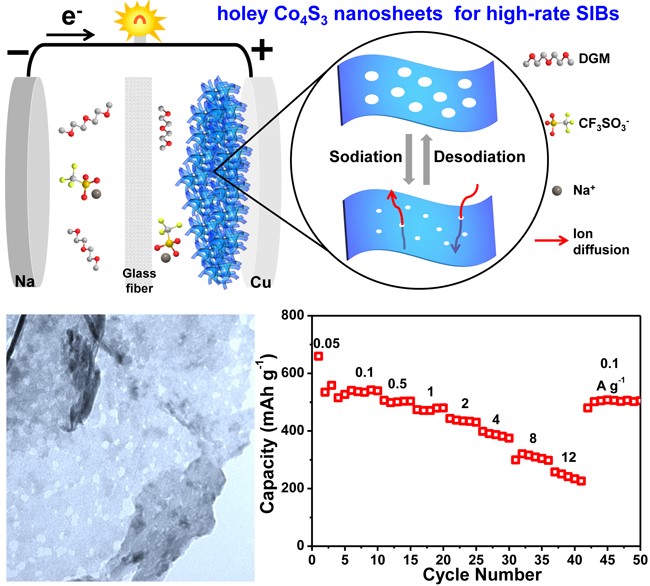Y.F. Dong, W. S. P.F. Lu, J.Q. Qin, S.H. Zheng, B.S. Zhang, X.H. Bao, Z.-S. Wu*
Journal of Materials Chemistry A, 2018, 6, 14324-14329.
DOI: 10.1039/C8TA05612A [PDF]
Themed Collections: Journal of Materials Chemistry A top 5% most-read Q3 (1)
 Sodium ion batteries (SIBs) for large-scale grid applications are facing great challenges in development of high-performance electrode materials and screening of suitable electrolytes. Herein, a versatile and scalable protocol of synthesizing two-dimensional (2D) holey cobalt sulfide (h-Co4S3) nanosheets is demonstrated for high-rate and long-life SIBs in an ether-based electrolyte of 1.0 M NaCF3SO3 in diglyme. The 2D h-Co4S3 nanosheets is prepared by sulfuration of leaf-like cobalt based metal-organic frameworks (CoMOFs), and subsequent annealing treatment. Benefiting from the nanosheet nature of holey nanopores (10-30 nm), ultra-thinness (<30 nm), crumpled morphology, and micron lateral size that can provide enriched active sites and enhanced sodiation/desodiation kinetics, the resulting h-co4s3 nanosheets achieves high reversible capacity of 571 ma h g−1 at 0.1 a g−1, and long-life cycling stability with retention of 80% after 400 times for sibs. furthermore, theoretical simulation elucidates the enhance structure stability of h-co4s3 nanosheets with lower binding energy (0.31 ev) of co-o bond in ether-based electrolyte than that in carbonate-based electrolyte. notably, h-co4s3 anode offeres exceptional rate capacity of 257 mah g−1 at 12 a g−1, outperforming most reported cobalt sulfide–based anodes. this strategy will pave a new way to rationally construct mofs-derived 2d nanostructures for various energy-related applications. |